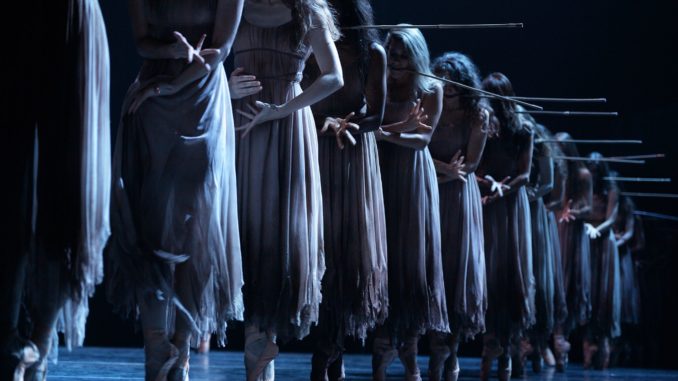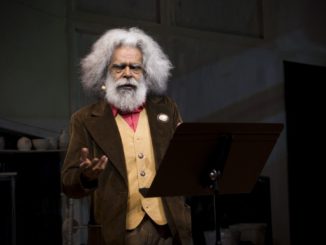
[A Masterpiece]
The build-up to Akram Khan’s Giselle opening in Auckland has been significant: a visit ten years in planning by Auckland Arts Festival Director Jonathan Bielski; nearly one hundred cast and crew on English National Ballet’s first visit to New Zealand; a significant reinterpretation of a well-loved romantic ballet by a bold, modern choreographer; the debut international performance occurring before our eyes. Listen to the hype – Akram Khan knocks it out of the park with his Giselle. Simply, it is a masterpiece.
The production is a perfect synthesis of its elements. While the choreography, sound, set design and costume are sophisticated works of art and design individually, together they are a transformative, dystopian powerhouse. Khan’s Giselle is inseparable from Vicenzo Lamagna’s score of industrial, pulsing, melodic, essential waves of instrumentation and sound. The collaboration between Khan and Lamanga is the meeting of equal and courageous forces; sometimes the movement is perfectly suited to the sound, sometimes the sound perfectly suited to the dancer. I especially appreciated the use of crescendo, stillness/silence as a source of contrast in Giselle, including the occasional and deliberate blurring on either side of these effects.
Tim Yip’s visual and costume designs are as dramatic and effective as the choreography and sound. A muted palette of simple, fluid garments for the Outcasts (who replace the Peasants from the romantic version of Giselle) feel thoroughly modern, whilst referencing classical originals. Yip reveals his strength and sophistication as a designer with the exaggerated luxury of the Landlords’ silhouettes, and the industrially dehumanising set.
Omnipresent, an enormous wall taps into the global consciousness of widening gaps, increasing fear, the language of capitalism and disposable people. It literally divides the Outcasts and the Landlords, but figuratively evokes current political rhetoric with the insistence of an immovable object. Without giving too much away, the wall at the end of Act 1 is like something from a nightmare – an incomparable effect.
Khan transforms setting and structure in his Giselle, the community of migrant garment factory workers informed by the polarised textile industries of Manchester, United Kingdom and Dhaka, Bangladesh. The classical narrative of the ballet remains, with the peasant utopia flipped to a present-day sweatshop dystopia, with an insecure, migrant workforce of mostly women. The weight of the garment factory setting is felt choreographically throughout the performance, and includes a human loom in Act 1, warps and weft created by ensemble formations, cat’s cradle of bamboo cranes ensnaring Hilarion in Act 2, and needle-like precision of the canes as sources of both connection and control.
Throughout the work, Khan’s choreography references and respects the original Giselle brilliantly. Motif and development are one element of this, but equally effective are the leitmotifs and movements retained by Yin and Khan – Giselle playfully moving out of reach of Albrecht’s kisses in Act 1, for example, or her spirit evading his embrace in Act 2. In keeping with the early productions of Giselle, Khan retains the use of pointe for the second Act. This ensures the artists’ suburb classical technique evokes an ethereal world, as escapist as the original was intended to be, if a lot darker. Add to this Khan’s masterful manipulation of formation, positioning of soloists, a rich vocabulary of animalistic movements with varied cultural influences, skilled use of elevation and levels, and it is easy to see why this is a choreographer at the top of his game.
A work of the calibre of Akram Khan’s Giselle, of course, cannot be realised without dancers of exquisite technical proficiency. The dancers of the English National Ballet are raw, visceral and powerful in their performance. The speed and strength across the stage reveal a company that is youthful, vital, brave. Erina Takahasi as Giselle dances as though laws of physics don’t quite apply to her. Alongside the strength and dexterity we expect of a Lead Principal, Takahasi can stop so quickly and with such control that it is breath-taking to watch. The Act 2 pas de deux with Isaac Hernández as Albrecht is an exquisite piece of choreography – contemporary, magnetic and emotionally authentic. The level of partnering between these two remarkable dancers is a real treat for New Zealand audiences to experience live.
As Hilarion, guest Artist Oscar Chacon performs with wit, detail and agility, and brings to Khan’s Giselle a developed and three-dimensional characterisation of a chameleon moving between Giselle and Albrecht, the Outcasts and the Landlords. Principal Begoña Cao in the largely non-dancing role of Bathilde (Albrecht’s Landlord fiancé) gives a performance rich with subtlety and nuance – Khan and Cao know that the simple act of dropping a glove can capture an audience and fill a theatre with meaning.
Traditionally a ballet blanc, the Wilis of Act 2 are a powerful phalanx of women, existing in a ‘ghost’ factory where they have laboured but never escaped. Khan’s settings evokes the imagery of a disposable workforce, exposed to exploitation, global corporate greed, and industrial accidents caused by exhaustion or neglect. First Artist Stina Quagebeur creates a horror-movie ghost Mytha with contortions and isolations perfectly suited to the dark power of her role. Flanked by her corps of Wilis, the women consume the stage with lightning-fast bourrée en courou and the illusion of weightlessness.
Akram Khan’s Giselle does what we want great art to do – holds a mirror up to us, pushes us to look at the unflattering reflection, moves us away from our everyday experiences, speaks to us with tactile multi-sensory tangibility.
Akram Khan’s Giselle is presented by the English National Ballet and plays at the Aotea Centre until 4 March as part of the Auckland Arts Festival.




Leave a Reply